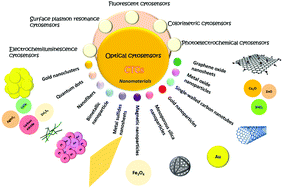Optical cytosensors for the detection of circulating tumour cells
Abstract
Blood analysis is an established approach to monitor various diseases, ranging from heart defects and diabetes to cancer. Among various tumor markers in the blood, circulating tumor cells (CTCs) have received increasing attention due to the fact that they originate directly from the tumors. Capturing and detecting CTCs represents a promising approach in cancer diagnostics and clinical management of cancers. CTCs in blood progress to self-seeding a tumour or initiating a new lesion mass. Cytosensors are biosensors intended to identify CTCs in a blood sample of cancer patients and provide information about the cancer status. Herein, we firstly discuss different detection methods of state-of-the-art optical cytosensors, including colorimetry, fluorescence, surface plasmon resonance, photoelectrochemistry and electrochemiluminescence. Then we review the significant advances made in implementing biorecognition elements and nanomaterials for the detection of cancer cells. Despite great progress in optical cytosensors, and their integration with smartphones, they have still only been explored to prototype stages. Much more effort is needed to fulfil their potential in modern cancer diagnostics and in monitoring the state of disease for cancer patients.

- This article is part of the themed collection: Journal of Materials Chemistry B Recent Review Articles


 Please wait while we load your content...
Please wait while we load your content...